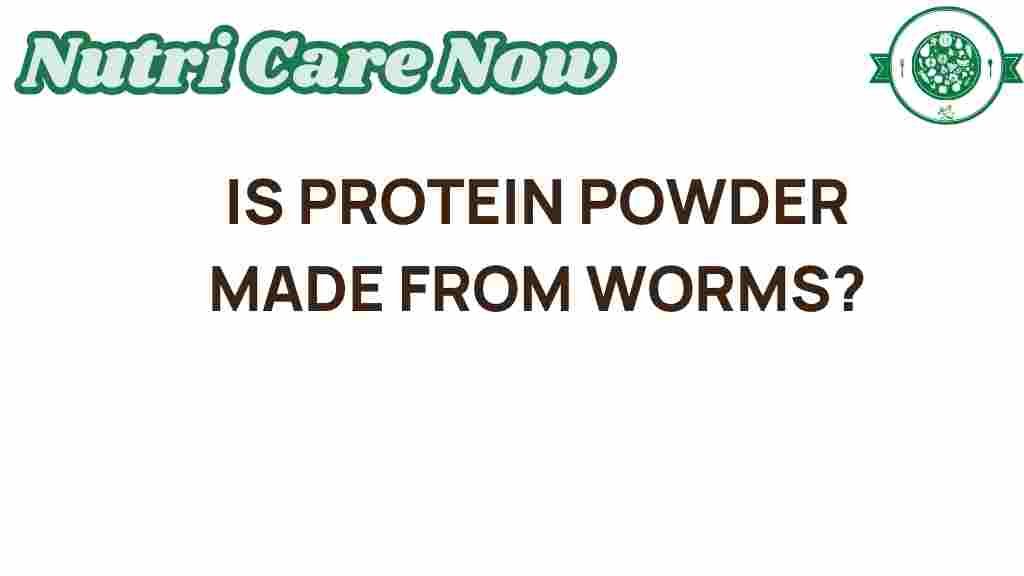Is Protein Powder Really Made from Worms? The Surprising Truth Unveiled
In recent years, the popularity of protein powder has surged, with many health enthusiasts and fitness lovers incorporating it into their diets. As the demand for sustainable protein sources grows, questions arise about the origins of these powders. One rumor that has circulated is whether protein powder is made from worms. In this article, we will delve into the truth behind this claim, explore the world of sustainable protein, and discuss the health innovations surrounding alternative protein sources.
Understanding Protein Powder
Protein powder is a dietary supplement designed to provide a concentrated source of protein. It is commonly used by athletes, bodybuilders, and individuals looking to increase their protein intake for various health benefits. Protein powders can be derived from several sources, including:
- Whey Protein: A byproduct of cheese manufacturing, whey is one of the most popular protein powders.
- Casein Protein: Another dairy-derived protein that digests slowly, offering a steady release of amino acids.
- Plant-Based Proteins: Sources like pea, rice, hemp, and soy are gaining traction among vegetarians and vegans.
- Insect Protein: Emerging as a sustainable protein source, insects such as crickets and mealworms are rich in protein.
The Rise of Sustainable Protein
As the global population continues to grow, so does the demand for protein. Traditional livestock farming has significant environmental impacts, including greenhouse gas emissions and land degradation. This has led to a rise in interest in sustainable protein sources. Here are some key points regarding sustainable protein:
- **Lower Carbon Footprint:** Insects require less land, water, and feed compared to traditional livestock.
- **Efficient Feed Conversion:** Insects can convert feed into protein much more efficiently than cattle or pigs.
- **Nutrient-Rich:** Insect protein is not only sustainable but also rich in essential nutrients, including vitamins and minerals.
Worm Protein: The Truth Behind the Rumor
So, is protein powder really made from worms? The short answer is: not typically. Most commercially available protein powders are derived from the sources mentioned above, primarily whey, casein, or plant-based proteins. However, some companies are exploring insect protein, which includes mealworms and crickets, as an alternative source.
While mealworms fall into the category of insect protein, they are not the same as worms traditionally understood in the ecological sense. Instead, they are larvae of the darkling beetle and are gaining attention for their high protein content and sustainability. The use of insect protein is part of a broader trend toward eco-friendly diets and health innovations.
The Nutritional Profile of Insect Protein
Insect protein, such as that derived from mealworms, boasts a compelling nutritional profile:
- High Protein Content: Mealworms contain approximately 60-70% protein by weight.
- Rich in Essential Amino Acids: They provide all nine essential amino acids needed for human health.
- Vitamins and Minerals: Insects are also good sources of iron, zinc, and B vitamins.
Food Trends and Health Innovations
The incorporation of insect protein into food products is becoming a notable trend in the health and nutrition sectors. As more people seek alternative protein sources, several innovative products are emerging:
- Protein Bars: Many brands now offer protein bars made with cricket flour.
- Protein Powders: Some protein powders blend traditional sources with insect protein to enhance nutritional value.
- Snack Foods: Chips and snacks made with insect flour are gaining popularity.
These innovations not only cater to health-conscious consumers but also address sustainability concerns, making them attractive options for eco-friendly diets.
How to Incorporate Protein Powder into Your Diet
If you’re considering incorporating protein powder into your diet, here’s a step-by-step guide:
- Choose Your Protein Powder: Decide between whey, plant-based, or insect protein based on your dietary preferences and goals.
- Start with Small Amounts: If you’re new to protein powder, begin with a small serving to assess your tolerance.
- Mix with Liquid: Blend your protein powder with water, milk, or a dairy alternative for a quick shake.
- Add to Recipes: Incorporate protein powder into smoothies, oatmeal, or baked goods for an added protein boost.
- Monitor Your Intake: Keep track of your daily protein intake to ensure you meet your nutritional needs.
Troubleshooting Common Issues
While incorporating protein powder into your diet can be beneficial, you may encounter some issues. Here are some troubleshooting tips:
- Digestive Discomfort: If you experience bloating or gas, try switching to a different protein source or reducing the serving size.
- Unpleasant Taste: Mix protein powder with flavored liquids or add fruits to improve taste.
- Difficulty Finding Products: Look for specialty health stores or online retailers that offer a variety of protein powders, including those made from insects.
The Future of Protein Powder
As the focus on sustainability and health continues to grow, the future of protein powder is likely to see significant changes. Here are some potential developments:
- Increased Popularity of Insect Protein: As consumers become more aware of the benefits, we may see a rise in products featuring mealworm and cricket protein.
- Innovative Blends: Expect to see more protein powders that blend various sources to provide a complete amino acid profile.
- Focus on Transparency: Companies may increasingly provide detailed sourcing information to meet consumer demand for transparency.
Conclusion
In conclusion, while protein powder is not typically made from worms, the inclusion of insect protein, such as mealworms, is becoming a relevant topic in the world of sustainable protein. As consumers look for eco-friendly dietary options and innovative health solutions, the market for alternative protein sources is expanding rapidly. By understanding the nutritional benefits and trends surrounding protein powder, individuals can make informed choices that align with their health goals while contributing to a more sustainable food system.
If you’re interested in exploring more about alternative protein sources, consider checking out this comprehensive guide on sustainable eating. For additional insights into protein types and their benefits, visit this nutrition facts resource.
This article is in the category Trends and created by NutriCareNow Team
